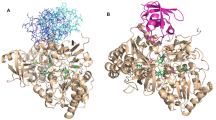Abstract
Rubredoxin is a small iron-sulfur (FeS4) protein involved in oxidation–reduction reactions. The side chain of Leu41 near the iron-sulfur center has two conformations, which we suggested previously serve as a gate for a water molecule during the electron transfer process. To establish the role of residue 41 in electron transfer, an [L41A] mutant of Clostridium pasteurianum rubredoxin was constructed and crystallized in both oxidation states. Despite the lack of the gating side chain in this protein, the structure of the reduced [L41A] rubredoxin reveals a specific water molecule in the same position as observed in the reduced wild-type rubredoxin. In contrast, both the wild-type and [L41A] rubredoxins in the oxidized state do not have water molecules in this location. The reduction potential of the [L41A] variant was ~50 mV more positive than wild-type. Based on these observations, it is proposed that the site around the Sγ of Cys9 serves as a port for an electron acceptor. Lastly, the Fe–S distances of the reduced rubredoxin are expanded, while the hydrogen bonds between Sγ of the cysteines and the backbone amide nitrogens are shortened compared to its oxidized counterpart. This small structural perturbation in the Fe(II)/Fe(III) transition is closely related to the small energy difference which is important in an effective electron transfer agent.




Similar content being viewed by others
References
Cammack R (1992) Adv Inorg Chem 38:281–322
Beinert H, Holm RH, Munck E (1997) Science 277:653–659
Sieker LC, Stenkamp RE, LeGall J (1994) In: Peck HD Jr, LeGall J (eds) Methods in enzymology, vol 243. Academic Press, San Diego, pp 203–216
Gray HB, Winkler JR (1996) Annu Rev Biochem 65:537–561
Swartz PD, Beck BW, Ichiye T (1996) Biophys J 71:2958–2969
Johnson MK (1998) Curr Opin Chem Biol 2:173–181
Meyer J, Moulis J-M (2001) In: Messerschmidt A, Huber R, Wieghardt K, Poulos T (eds) Handbook of metalloproteins, vol 1. Wiley, New York, pp 505–517
Maher MJ, Xiao Z, Wilce MC, Guss JM, Wedd AG (1999) Acta Crystallogr Sect D 55:962–968
Yelle RB, Park N-S, Ichiye T (1995) Proteins 22:154–167
Min T, Ergenacan C, Eidness M, Ichiye T, Kang C (2001) Protein Sci 10:613–621
Ausubel FM, Brent R, Kingston RE, Moore DD, Seidman JG, Smith JA, Struhl K (2000) Current protocols in molecular biology. Wiley, New York
Eidsness MK, Burden AE, Rchie KA, Kurtz DM Jr, Scott RA, Smith ET, Ichiye T, Beard B, Min T, Kang C (1999) Biochemistry 38:14803–14809
Smith ET, Bennett DW, Feinberg BA (1991) Anal Chim Acta 251:27–33
Navaza J (1994) Acta Crystallogr Sect A 50:157–163
Brunger AT (1992) X-PLOR: a system for crystallography and NMR, version 3.1. Yale University, New Haven
Dauter Z, Wilson KS, Sieker LC, Moulis JM, Meyer J (1996) Proc Natl Acad Sci USA 93:8836–8840
Kennepohl P, Solomon EI (2003) Inorg Chem 42:696–708
Day MW, Hsu BT, Joshua TL, Park JB, Zhou ZH, Adams MW, Rees DC (1992) Protein Sci 1:1494–1507
Tezcan FA, Crane BR, Winkler JR, Gray HB (2001) Proc Natl Acad Sci USA 98:5002–5006
Acknowledgement
This work was supported by grants from NIH to TI (R01-GM4503) and CHK (R01-GM66173).
Author information
Authors and Affiliations
Corresponding author
Rights and permissions
About this article
Cite this article
Park, I.Y., Youn, B., Harley, J.L. et al. The unique hydrogen bonded water in the reduced form of Clostridium pasteurianum rubredoxin and its possible role in electron transfer. J Biol Inorg Chem 9, 423–428 (2004). https://doi.org/10.1007/s00775-004-0542-3
Received:
Accepted:
Published:
Issue Date:
DOI: https://doi.org/10.1007/s00775-004-0542-3




